- NLI Research Institute >
- Medium-Term Economic Forecast for Japan
Medium-Term Economic Forecast for Japan
the Economic Research Dept.
Font size
- S
- M
- L
Japan's population is aging faster than predicted. Meanwhile, the economic recovery remains weak. The next five-year period to fiscal 2001 will determine the future course of the economy through reforms to prepare for the aging era and attempts to overcome the aftereffects of the collapse of the bubble economy. Amid ongoing structural reform, the real growth rate will average 1.6%, well below the estimated potential growth rate of approximately 2.5%. In this paper, we look at the long-term prospects for issues related to aging, and then consider medium-term trends based on present economic conditions.
Impact of Aging on the Economy
Japan stands at the entrance of an aged society. According to the latest population projections by the National Institute on Social Security and Population Issues, over 20% of the population will be at least 65 years old by 2006. The 15-64 age segment of the population peaked in 1994 and has been declining. The next five-year period can be characterized as a transitional period to the full-fledged aging society of the 21st century. From 2005 to 2010, the baby boom generation will reach retirement age, after which the economy will feel the impact of declining work force due to aging.
The latest population projections show that aging is advancing faster than had been predicted, and the proportion of elderly is people consequently rising higher. While the number of elderly remains unchanged from previous projections, the population of younger people has been revised downward significantly. To alleviate the problems associated with aging in the 21st century, policies must address ways to increase the birthrate and reduce the burden of child care on working women.
However, aging will not become full-fledged during our forecast period, and while the productive segment of the population (age 15-64) will decline, the labor force will grow moderately as the labor force participation rate of women is expected to continue rising. Thus based on the economy's productive capacity, we predict that the economy will maintain a potential growth rate of approximately 2.5%.
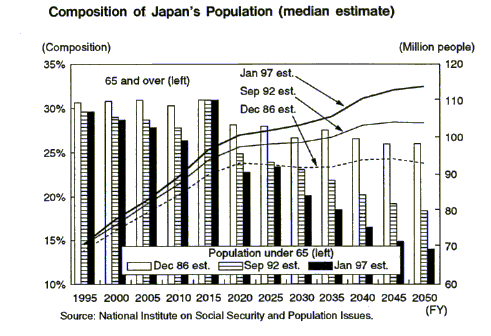
Present Economic Conditions and Policy Issues
■Capital Investment is Recovering; Bubble Economy's Aftereffects Linger
After peaking in February 1991, the economy slid into recession as the bubble economy collapsed, and foundered until October 1993. Although a recovery is now underway, it is slower and weaker than previous recoveries, having been temporarily interrupted by a yen surge in the spring of 1995, and halted again in the spring of 1996 due partly to inventory adjustment.
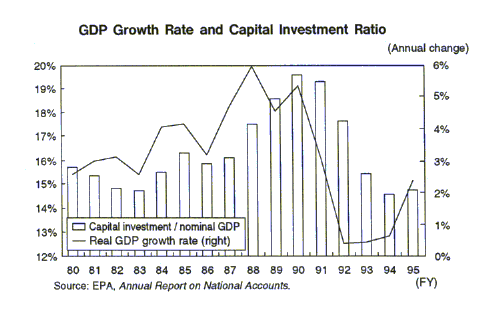
The single largest factor behind the recession has been a reactive decline from the excessive investment levels during the bubble period. In fiscal 1990, the ratio of capital investment to nominal GDP almost reached 20%, comparable to levels during Japan's rapid growth era. But when investment contracted, economic growth stagnated. Investment began growing again in fiscal 1994 and has continued to grow. Investment demand has surged in new growth areas such as cellular and PHS telecommunications, while semiconductors perked up in FY 1995 and automobiles in FY 1996. Growth in investment has been gradually spreading across industries and smaller companies.
Still, the recovery in investment has depended heavily on demand in new areas. As exemplified by office buildings in major cities, much of the excessive investment of the bubble era remains to be absorbed, and conditions have not warranted new investment. The lingering effect of the bubble economy is not limited to investment. Predicting a future shortage of young workers, companies expanded their payrolls during the bubble era. When the recession struck, they had too many workers, and sought ways to cut labor costs. Corporate balance sheetshave still not recovered from the collapse of the asset bubble. Furthermore, with financial institutions still working to dispose of their bad loans and the stock market still soft, anxiety over the financial system lingers. Thus the economy has not yet shaken off the aftereffects of the bubble economy's collapse.
■Yen Correction Revives External Demand; Structural Adjustments Continue
One factor hampering the recovery has been a vicious circle in which the strong yen squeezes corporate profits, which in turn depresses capital investment, dampens imports, expands the current surplus, and pushes the yen even higher. Although the balance of payments effect of the strong yen did not appear immediately, the strong yen continued to boost imports substantially, causing the current surplus to decline. After the yen peaked in April 1995 at less than ¥80 to the dollar, it underwent a prolonged correction that brought it down to the ¥120 range as of February 1997. This caused import growth to slow as exports recovered, and since midyear FY 1996 external demand has turned around to prop up the economy. Industrial production also overcame a temporary lull and returned to a recovery track, picking up speed in the second half of FY 1996 from the anticipated last minute demand rush ahead of the consumption tax hike in FY 1997.
The strong yen has spurred finished product imports. Product imports from the technologically advancing Southeast Asian countries are expected to continue even if the yen stops surging. While having captured large market shares in the world market through technological innovation and cost cutting, Japanese companies have trailed the U.S. in the expanding personal computer market. For the time being, Japanese companies face an adjustment phase in the industrial structure to meet competition from the newly industrialized countries, and in economic and social systems that will enable them to compete with the industrialized countries through revolutionary advances in technology and management.
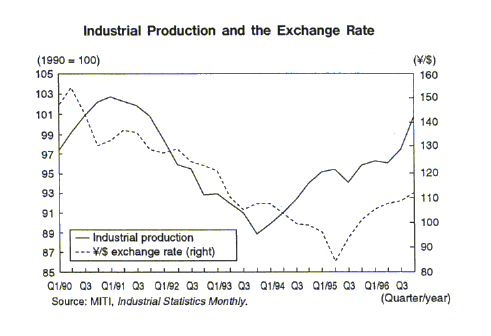
■Ballooning Fiscal Deficit
After the bubble economy collapsed, the government issued construction bonds to finance public works projects and deficit-financing bonds to offset tax cuts. These bonds, coupled with the incomplete administrative reforms of the 1980s, pushed the fiscal deficit up substantially, giving Japan one of the largest fiscal deficits among the industrialized countries. In fiscal 1996, the government issued ¥22.4 trillion in government bonds, amounting to 28.8% of the general budget account. In fiscal 1997, new bond issues will decline due to the consumption tax hike and ending of the special income tax cut. Still, total outstanding bonds are expected to exceed ¥250 trillion.
Moreover, by the middle of the 21st century, government spending will balloon from massive pension benefits and medical spending for the aging population. This will cause the fiscal deficit to surge unless the present share of expenses borne by the public is raised. Under present arrangements, the share of expenses borne by the public would have to rise well above the government's targeted 40% range; and if public nursing care insurance is introduced, the public's share may even greatly exceed 50%.
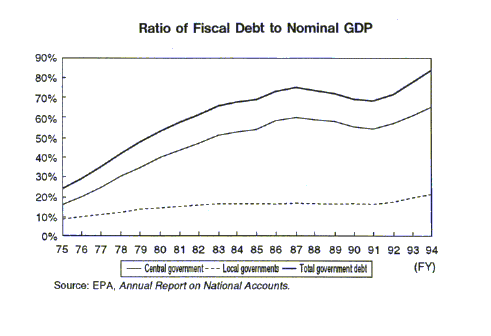
■Policies for Substantive Structural Reform
The economy faces two critical issues: in the long term, changes in economic and social systems to accommodate the aging population in the 21st century, and in the short term, overcoming the aftereffects of the bubble's collapse.
The success of the "Japanese system" in the postwar era was based on rational systems that accommodated specific economic and social conditions. But as Japan faces great change due to its aging population, conditions have changed greatly, and reforms are needed.
Most important is the reevaluation of the social security system. To prevent the cost burden from overwhelming the public, the social security system must be drastically reformed. The public's share of the burden of maintaining the social security system will skyrocket by the mid-21st century. However, since reforms in this area will require a long period of adjustment for the public, the bulk of reforms will need to be implemented early in the next century.
Regarding cyclical issues, structural reforms need to be pursued centered around further deregulation amid the restructuring of corporate and public finance. The Hashimoto cabinet has proposed six major reforms covering governmental administration, the economic structure, financial system, social security structure, public finance structure, and education. In the long term, these reforms will increase the economy's capacity to grow, and must not be postponed on the basis of adjustment costs. The full implementation of these reforms is fundamental to addressing the economy's cyclical and long-term issues.
Medium-term Forecast
Assumptions
■World Economy Improves in the Late 1990s
The world economy will achieve relatively favorable growth over the next five years. Sluggishness in the first half of the decade was due to the lackluster performance of the industrialized economies and recessions in the former planned economies and Africa. The latter part of the decade will see improved growth, although not as high as in the somewhat abnormal boom of the late 1980s.
In Asia, China's high growth rate will decline slightly due to anti-inflationary policies. The NIEs, including new OECD member Korea, will maintain high but slower growth as the economies mature. While ASEAN countries will maintain high growth, the overall East Asia economy will slow. The former Soviet Union, Eastern Europe, and Africa will all turn around and post positive growth, while the U.S. will successfully contain inflation and see prolonged growth as the global leader in information technology. Europe's growth will improve over the sluggish early 1990s as capital investment grows in advance of the monetary union in 1999.
Compared to the inflationary 1970s and 1980s, global inflation has abated significantly in the 1990s. As industrialized nations strive to cut fiscal deficits, there is less crowding-out of private investment and long-term interest rates are falling. These trends will continue in the medium term as the world economy enjoys low inflation and interest rates for the next few years.
Lower interest rates in industrialized nations will benefit developing countries by reducing their interest payments on debt. For industrialized countries, lower interest rates will spur capital investment, more than offsetting the lower aggregate demand from reduced fiscal spending.

■Growth of Regional Economic Markets
The growing momentum toward regional markets such as the EU and NAFTA will serve to expand global trade rather than promote exclusive economic blocks. This is especially true of APEC in Asia. The probability is high that the EU's monetary union will start in 1999 with eight core members. In the coming "era of mega-competition," competition and strategic alliances will transcend national borders as corporate activity becomes increasingly globalized.
Assumptions Regarding Fiscal and Monetary Policies
We assume that taxes will not be increased after fiscal 1997's 2% consumption tax hike and discontinuation of the special income tax cuts begun in fiscal 1994. However, since inflation will reduce the minimum taxable income in real terms, the actual tax burden will edge upward. Due to tightening in fiscal spending, we assume that the current public works investment basic plan will be extended by two years. As a result, public works spending (public fixed capital formation) will remain almost flat beyond fiscal 1997. Due to administrative reforms, we also assume that government consumption will grow approximately 1% in real terms, falling below average levels of recent years. With regard to social security burdens and benefits, we assume that the present pension and medical insurance systems will persist.
In monetary policy, judging from the stability of prices, interest rates will basically remain low. However, we think that as the economy shrugs off the effect of the tax increases, the official discount rate will be raised to 1% by early fiscal 1998, followed by additional interest rate hikes.
As for the yen/dollar exchange rate, based on foreign and domestic inflation rates and external surplus trend, we predict that the yen will appreciate from ¥112 in fiscal 1997 to ¥105 in fiscal 2001.
Medium-term Growth Path
We predict that the economy will come to a standstill in the first half of fiscal 1997 due to the combination of the consumption tax hike, discontinued special income tax cuts, and tightening of fiscal spending to levels prior to the stimulus packages.
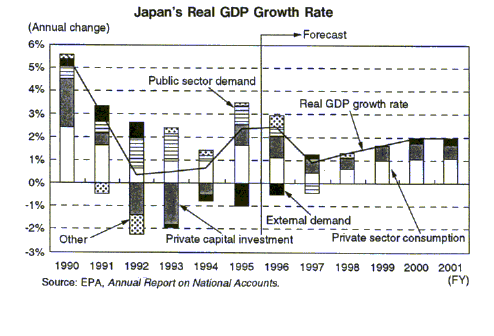
However, with business fixed investment gaining strength, the standstill will be short-lived as the economy resumes its recovery in fiscal 1998. From then, while not as abrupt as in fiscal 1997, tax and social security burdens will continue growing while fiscal spending gets tightens. Ongoing structural adjustments and the private sector's restructuring efforts will hold down the economy's growth potential. The low economic growth and easing conditions in the labor market will keep prices on a stable trend.
Fiscal Balance
Japan's fiscal balance is deteriorating rapidly. If we divide the public sector into an entitlement budget (pensions and medical insurance) and government budget (national and local entities), we see that the entitlement budget has posted surpluses equivalent to approximately 3% of nominal GDP, while the government sector's deficit in fiscal 1995 was equivalent to approximately 7% of nominal GDP. Assuming that the present social security system is continued, the 3% GDP ratio in excess savings of the entitlement budget will decline slightly during our forecast period, but the government's deficit will put the combined public sector's fiscal balance (investment-saving balance) in deficit equivalent to approximately 2% of nominal GDP. The government aims by fiscal 2005 to reduce the government deficit to approximately 3% of nominal GDP, which is the standard for the EU's single currency, but is not likely to reach this target by fiscal 2001.
External Balance
Japan's external balance (current account balance) will show a slightly expanding surplus. In terms of the IS balance, aging will not cause a significant decline in the household savings rate during the forecast period. Residential investment grew strongly in fiscal 1996 due to falling land prices, very low interest rates, and the anticipated consumption tax hike. But looking ahead over the medium term, private residential investment will grow more slowly, partly to correct for the past high growth. Indeed, because household savings are likely to increase once social security reforms are scheduled and public pension benefits are reduced, we predict that excess savings in the household sector will exceed 6% of nominal GDP in fiscal 2001.
Excess investment in the corporate sector, which plunged to nearly zero after the collapse of the bubble economy, will expand gradually. However, significant growth in investment is unlikely in light of the economy's slow growth. Considering the bubble economy's aftermath of massive capital stock adjustments, excess investment cannot return to the unsustainable levels in the late 1980s to early 1990s, when it exceeded 5% of nominal GDP. Thus we predict that excess investment in the corporate sector will expand to approximately 2% of nominal GDP by fiscal 2001.
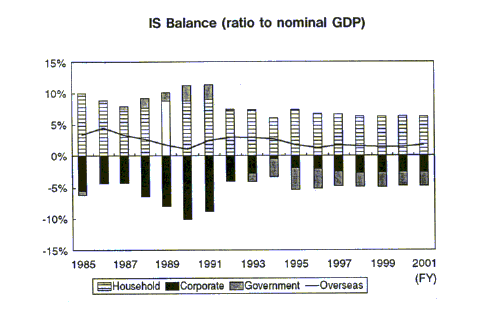
Since the domestic economy's aggregate IS balance is equivalent to the external balance, the combined IS components described above point to a current surplus of slightly less than 2% of nominal GDP. This conforms with our assumption that the yen will appreciate only moderately from the present yen/dollar exchange rate of ¥120.
At this exchange rate level, we predict that the external surplus will tend to expand in proportion to nominal GDP due to increasing competition from NIEs and ASEAN exports and strong growth of the world economy. However, the external surplus will not expand significantly. While imports may have problems entering new markets, the imports that became established in Japan during previous strong yen phases will not be driven out by a moderately weaker yen. An additional factor is the structural changes caused by the strong yen in the past-companies that have shifted production overseas to avoid the strong yen's impact cannot easily move back to Japan.
Persistently High Unemployment Rate
Increase in frictional unemployment
Despite the prolonged recession following the collapse of the bubble economy, Japan's unemployment rate remains low compared to the rest of the world-lower than the double-digit unemployment in Germany and other European countries, and lower than in the U.S., where labor shortages are spurring inflationary concerns. Reasons for Japan's low unemployment rate include the omission of the growing number of discouraged workers from unemployment statistics, the reluctance of companies to dismiss excess workers, and the ability of companies to adjust labor inputs by reducing overtime rather than by trimming payrolls.
In fiscal 1992, the government began a series of massive economic stimulus packages that focused on public works projects. This fiscal spending increased the number of employed workers in the construction industry. But as fiscal tightening has curtailed such projects, there is concern that frictional unemployment will rise as workers shift to other industries. Since fiscal 1991, the year prior to the stimulus packages, the number of employed workers has declined substantially in manufacturing, agriculture, and forestry, while there has been a comparable increase primarily in services. The increase in construction workers is almost equivalent to the total increase in employed workers, and if this is excluded, the unemployment rate would rise by approximately 1 percentage point.
Despite the economic recovery, unemployment remains high in the 3% range. The increase in unemployment among young persons is especially noticeable. As more people change jobs, frictional unemployment will increase and push up the unemployment rate. For this reason, labor market conditions will not improve in the medium term, and income growth will be limited.
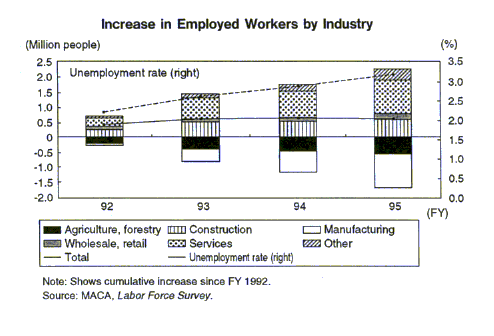
Transition of Employment System
The traditional employment system, premised on rising wages based on sustained growth and seniority, is undergoing change. If the economy's growth slows due to aging, companies will be less willing to retain excess workers in downturns, and unemployment will fluctuate more widely with economic conditions. Even at large companies with seniority-based wage structures and lifetime employment, employment will shift toward merit-based pay and salaries.
Changes in the industrial structure entail the movement of labor between companies and across industries. Thus Japan's labor market will become more similar to the U.S. and Europe. As this happens, households no longer assured of rising incomes will become more careful in taking out housing loans, and residential investment and consumer behavior will be more restrained.
Conclusion
The Japanese economy is confronted with two major issues: preparing for the aging society of the 21st century, and cleaning up the aftermath of the collapse of the bubble economy. In the medium term, the necessary adjustments may depress the economy's growth rate well below its potential growth rate. However, delaying reforms would only complicate matters and increase the pain of adjustment in the future.
In 1997, as the yen has weakened and stock prices have continued to fall, pessimism has spread regarding Japan's economy. But this does not diminish the towering accomplishments of Japan's postwar economy, making Japan one of the world's wealthiest nations today.
Of course, in the process Japan's economy and society have changed greatly, as has the rest of the world. The systems that produced Japan's economic success are not necessarily best suited to the new environment. For Japan to remain among the world's wealthiest and dynamic economies, drastic reforms need to be implemented.
Reforms come at a price. In some cases, change will inevitably threaten vested interests. But what Japan needs today is to build systems that will promote future economic progress without regard to the vested interests of individual industries, regions, or persons. Instead of fighting over a shrinking pie, Japan needs to go forward with reforms that will make the pie grow.
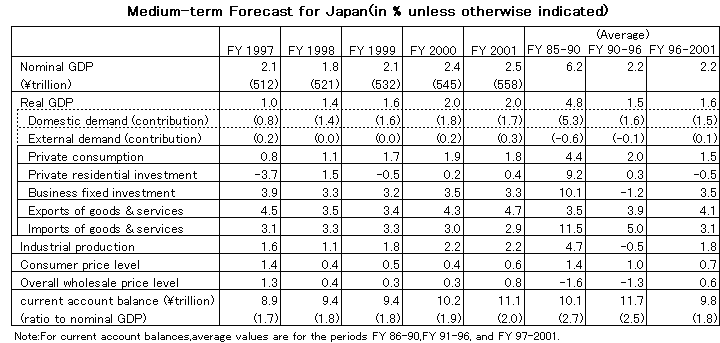
the Economic Research Dept.
Research field
レポート紹介
-
研究領域
-
経済
-
金融・為替
-
資産運用・資産形成
-
年金
-
社会保障制度
-
保険
-
不動産
-
経営・ビジネス
-
暮らし
-
ジェロントロジー(高齢社会総合研究)
-
医療・介護・健康・ヘルスケア
-
政策提言
-
-
注目テーマ・キーワード
-
統計・指標・重要イベント
-
媒体
- アクセスランキング

















